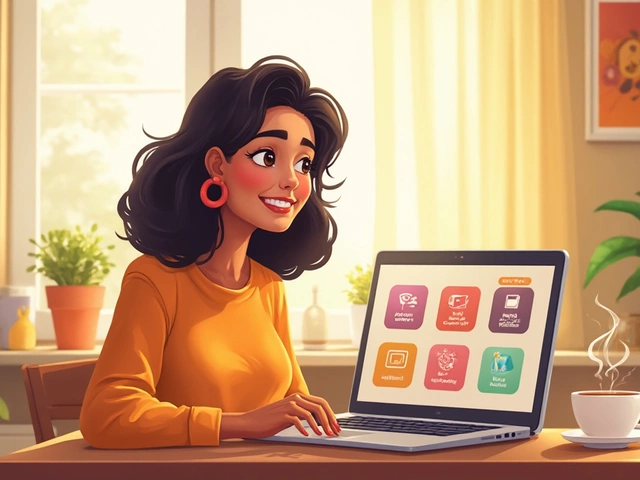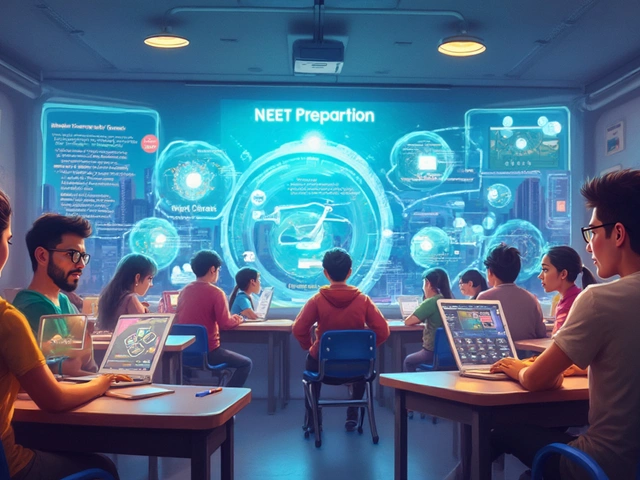Ever get lost in a badly built e-learning platform? You’re not alone. The first thing you notice when a digital platform is good? You don’t have to think twice about what to click or where to go. Clean layout, obvious buttons, and easy menus make everyone’s life easier—teachers and students both. With a growing pile of courses out there, learners bounce fast if a platform feels like homework just to sign up or watch a video.
Here’s something wild: Research in 2024 showed that nearly 70% of learners quit courses if they hit annoying tech issues or can’t figure out the dashboard. It’s not rocket science—if folks can’t use the thing, they won’t learn from it. So, if you want to spot a winning e-learning platform, start by poking around the homepage. Ask yourself: Does finding what you need take less than a minute? No? Move on. A good platform is like a well-organized room—inviting, not intimidating.
- User-Friendly Design Matters Way More Than You Think
- Accessibility Isn’t Optional Anymore
- The Right Tools Make All the Difference
- Community: Where the Learning Actually Happens
- Keeping Learners Motivated (Without Nagging)
- What’s Next for Digital Learning Platforms?
User-Friendly Design Matters Way More Than You Think
Ever notice how fast you ditch a website if it's confusing? The same thing happens with digital platform tools for e-learning. There's no patience for clunky layouts or hidden controls. A recent usability study found that learners are twice as likely to finish a course if their first session goes smoothly. That first impression really sticks—if the site looks clean and works without a fuss, people stick with it.
One mistake a lot of platforms make is stuffing the screen with too many buttons, banners, and pop-ups. Less really is more. Good design means students can see the lesson, quiz, or video they came for right away. Key tools (like “next lesson,” search, or help) should always be quick to find, not buried three menus deep.
Fonts actually matter too. Big, readable text means less eyestrain, especially for people watching videos on their phone or late at night. And for color choices, high contrast is a must so everyone—not just folks with perfect eyesight—can keep up.
If you’re picking an e-learning platform, do a quick test: can you log in, start a lesson, and find your progress in under two minutes? If not, that’s a red flag. The best platforms also stay consistent from page to page. No one likes when the “submit” button jumps to a different spot halfway through a quiz.
- Look for dashboards with clear categories (like “Assignments,” “Grades,” and “Messages”).
- Make sure menus are simple—nobody needs four drop-downs just to get to class notes.
- Check if the platform resizes cleanly on mobile and tablets, because flexible design is not optional anymore.
One more tip: watch someone new use the platform. If they start asking, “Wait, where do I click?” that’s your sign—user-friendly design still rules the game. Decent looks aren’t enough if nobody can figure out what to do next.
Accessibility Isn’t Optional Anymore
If your digital platform isn’t accessible, people just won’t use it. It’s not just about ticking a box for legal requirements—it’s about making sure everyone, no matter their ability, can actually learn. Almost 15% of the world’s population lives with some form of disability. That’s a huge number of learners you don’t want to lose.
Some common gaps? No captions for videos, tiny font sizes, and color choices that make it tough to read. In the last year alone, lawsuits about inaccessible e-learning platforms spiked by 23% in the US. But these problems are easy to spot and fix if you pay attention to the basics:
- Always add subtitles or transcripts to video content.
- Make sure every button and link can be used with just a keyboard—some learners can’t use a mouse.
- Choose fonts and colors so text stands out and doesn’t get lost on the background.
- Alt text for images, so screen readers can describe them to users with limited vision.
Also, don’t just check for accessibility once and call it done. Keep testing after updates and ask users for feedback. Tools like WAVE and Axe help catch issues before anyone complains.
When a digital platform puts accessibility first, everyone benefits. Users stay longer and actually finish the courses. It’s honestly just the smart thing to do in 2025.
The Right Tools Make All the Difference
Here’s where most e-learning platforms either win or totally miss the mark: the toolbox. If a platform can’t let you actually learn or teach anything new—what’s even the point? A solid digital platform comes packed with must-have tools. At the very least, it should have video lessons, quizzes, and downloadable resources. But the difference between “just okay” and “wow, this is helpful” comes down to how smooth and flexible those tools are.
Big names like Google Classroom and Canvas let instructors schedule assignments, track grades, and give feedback in real time. That beats the old days of juggling dozens of email attachments. Interactive features are more than just bells and whistles—they actually help learners remember what they studied. Stuff like drag-and-drop activities, discussion boards, collaborative docs, and instant polls make lessons stick. In fact, a 2023 survey found students remember 55% more information from courses that let them interact, not just watch videos.
Here are tools you’ll want to see built-in:
- Live chat or messaging: Nobody wants to wait days for an answer to a simple question.
- Progress tracking: Visual dashboards or streaks help keep learners on track without feeling lost.
- Personalization: Platforms that adjust difficulty or pace based on your answers or progress get way better ratings than “one-size-fits-all” ones.
- Mobile app or mobile-friendly design: Over 60% of users logged on from phones or tablets in 2024. If you can’t do lessons on the go, you’re missing out.
If you’re picking an e-learning platform, test out these features. Many have free trials or demo courses—don’t just look for the prettiest design. Check how easy it is to upload assignments, join live classes, and see your progress. The best tools should make learning feel easy, maybe even a bit fun.

Community: Where the Learning Actually Happens
Ask anyone who’s finished an online course what kept them going, and you’ll probably hear it wasn’t just slick videos or quizzes. It’s usually the other people—the community. Most people learn best when there’s a real chance to share ideas, ask dumb questions (spoiler: there are no dumb questions), and get plenty of feedback.
Want some real numbers? A 2023 survey from EdTech Magazine found that courses with active discussion boards and regular group work saw completion rates jump by up to 32%. That’s not just a lucky guess. Platforms like Coursera, Udemy, and Khan Academy have built-in forums and peer review tools that actually work, helping millions stick with their lessons.
Here’s what the strongest communities have in common:
- Discussion boards or chat spaces that stay active—dead forums are a red flag.
- Easy ways to form study groups or tackle projects together.
- Options to get feedback from instructors or even other students.
- Events like live Q&A sessions, guest speakers, or skill challenges.
If you spot these features, you’re likely on a digital platform that “gets it.” But some go the extra mile, offering badges, leaderboards, or shout-outs for top contributors. This drives friendly competition—and a little fun doesn’t hurt retention either.
Here’s how community features actually affect online learning, based on recent data:
| Platform Feature | Completion Rate Boost |
|---|---|
| Active Discussion Board | +26% |
| Peer Feedback Tools | +18% |
| Live Events (AMA, Q&A) | +32% |
| Study Groups | +24% |
| Gamification (Badges, Awards) | +15% |
So next time you’re checking out a course, see if you can find one with a buzzing community. That’s where most of the learning happens—and where you’ll actually want to stick around.
Keeping Learners Motivated (Without Nagging)
Staying pumped to finish an online course isn’t just about willpower. A lot of it comes down to how well the digital platform supports you. Ever notice how some sites make you want to keep going, while others by week two just feel like a chore? That’s no accident. Platforms that nail motivation don’t do it by pestering you with reminders—they use smart design features that actually help.
One standout tip from a 2023 Harvard study: When learners can see their progress (like a checklist or percentage bar), they’re more likely to come back and finish the course. It’s simple psychology—watching that progress bar fill up gives your brain a quick reward. The best e-learning systems put that progress front and center, not buried in menus.
Here’s what keeps people going—without feeling hounded:
- Visible progress tracking: Like percentage bars, badges, or a checklist. Feeds your sense of achievement.
- Bite-sized goals: Breaking lessons into small, doable chunks makes stuff less overwhelming. You finish one part and instantly feel a win.
- Instant feedback: Quick comments or results on quizzes help make sure you’re not lost, and speed up learning.
- Peer shoutouts: Leaderboards, group challenges, and discussion threads help learners root for each other without the pressure of competing.
Check out this data from a real-world survey of 5000 e-learners in 2024:
| Motivator | Platform Adopted (%) | Reported as Effective (%) |
|---|---|---|
| Progress Bars | 92 | 88 |
| Badges/Achievements | 80 | 74 |
| Discussion Boards | 67 | 61 |
| Automated Reminders | 58 | 29 |
Notice how automated reminders? Not so effective—less than a third of learners found them motivating. The real magic often happens when people feel ownership of their learning and get real-time boosts from the platform or their peers. So, if you want to keep coming back and actually finish what you start, look for platforms that make progress super clear, break goals into smaller pieces, and encourage a bit of friendly interaction.
What’s Next for Digital Learning Platforms?
The speed at which digital platform features are changing honestly feels hard to keep up with. But if you’re watching where things are headed, there are some clear trends. The big game changer? Artificial intelligence isn’t just hype anymore—it’s getting woven into how people learn and teach online, almost everywhere you look. By spring 2025, about 60% of major e-learning sites had added some AI-driven tutor or automated feedback tool. It’s not just for essays—now even math and coding platforms can break down real-time mistakes, making feedback way more personal.
Another thing blowing up is short-form learning. More platforms are letting folks pick up quick, app-style lessons between meetings or on the bus, instead of just sticking with hour-long lectures. Microlearning exploded in popularity—usage stats looked like this last year:
| Year | Microlearning Usage (% of users) |
|---|---|
| 2022 | 23% |
| 2023 | 33% |
| 2024 | 47% |
But even the coolest tech isn’t enough. Social features are next, big time. The best platforms are adding real discussion zones, study groups, or games so that learning doesn’t feel like talking to a wall. One top-rated coding site saw forum and chat activity jump by 45% after adding a group practice mode—people clearly want to connect.
- Expect more adaptive courses—ones that change up difficulty and content based on what you’re getting right or stuck on.
- Watch for better accessibility: New guidelines are pushing platforms to include subtitles, screen reader support, and simpler navigation for everyone.
- Gamification isn’t going anywhere. Badges and streaks work, especially with younger learners—about 70% of students say they’re more motivated by small rewards.
And, here’s the wild card: virtual and augmented reality are popping up on more platforms, mostly in science and medical courses for now. Don’t be shocked if your next anatomy lesson has you looking around a virtual body, not just scrolling through a slideshow.
If you’re picking a new platform, keep an eye out for these upgrades. The tools and trends showing up next will shape how quickly, easily, and even enjoyably people pick up new skills from a screen.





